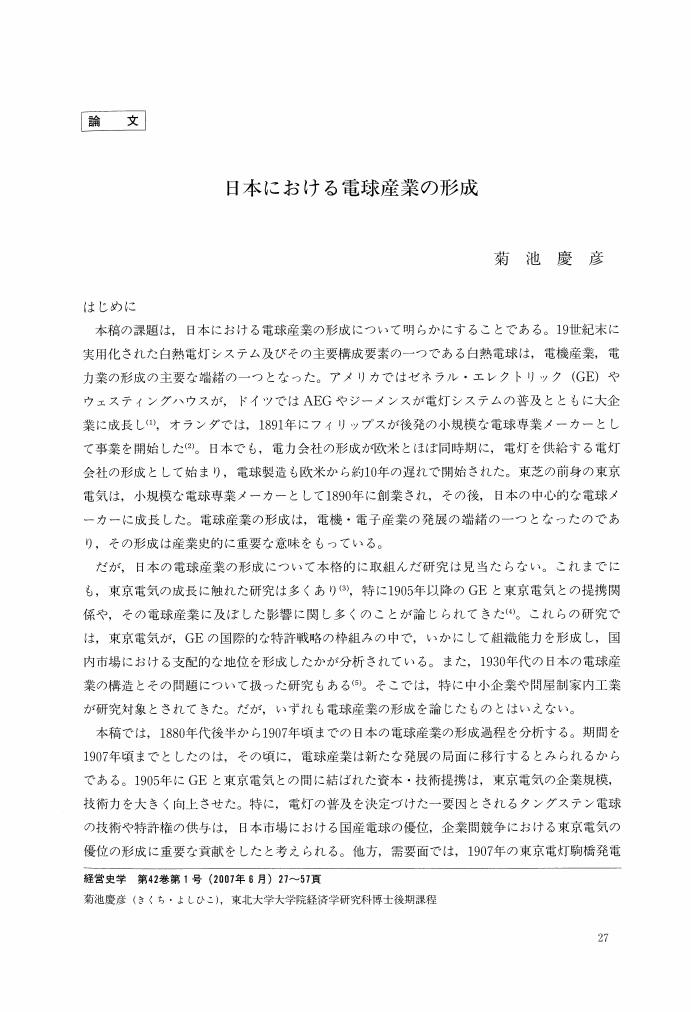2 0 0 0 OA 日本における電球産業の形成
1 0 0 0 OA タングステン電球の普及と東京電気の製品戦略
- 著者
- 菊池 慶彦
- 出版者
- Business History Society of Japan
- 雑誌
- 経営史学 (ISSN:03869113)
- 巻号頁・発行日
- vol.48, no.2, pp.2_27-2_52, 2013 (Released:2016-03-18)
- 参考文献数
- 63
This paper aims to analyze the diffusion of tungsten filament lamps in Japan and the strategy of Tokyo Electric.In the United States, General Electric (GE) developed drawn-wire tungsten lamps in 1910. This electric lamp was three times more efficient (w/candlepower) and lasted twice as long as a carbon filament lamp. In Japan, Tokyo Electric, a GE subsidiary, introduced tungsten lamps in 1911.Initially, this lamp was adopted by small scale electric power companies/utilities in rural areas and new market entrants in major city. Some electric power utilities in major cities were cautious in the introduction of the tungsten lamp. The revenues of electric power utilities may have declined if there was no increase in the demand for electrical lighting service, corresponding to the improvement in the efficiency of electric lamps. Tokyo Electric promoted tungsten lamps, by introducing them in installations with more and brighter electric lights. This served the mutual interest they shared with the electric power utilities, which was building a large customer base for lamp manufacturers.During World War I, many electric power utilities decided to introduce tungsten lamps and the main channel of distribution of the tungsten lamp was through a cooperative relationship with Tokyo Electric. Electric power utilities succeeded in internalizing the effect of improved lamp efficiency by revising the advantageous rates for electric lighting service. The tungsten lamps that were launched in Japan were adjusted for lower efficiency and longer life spans, compared with their US counterparts. Electric power utilities tend to emphasize the longer life spans. Furthermore, Tokyo Electric marked down the lamp price while maintaining quality standards. Thus, Tokyo Electric, which pioneered the distribution of tungsten lamps in Japan, reaped significant profits.
1 0 0 0 OA 日露戦後の電球産業の成長
- 著者
- 菊池 慶彦
- 出版者
- 経営史学会
- 雑誌
- 経営史学 (ISSN:03869113)
- 巻号頁・発行日
- vol.47, no.2, pp.2_3-2_29, 2012 (Released:2016-01-27)
The aim of this paper is to analyze the development of the Japanese electric lamp industry after the Russo-Japanese war. Subsequent to the war, the Japanese electric power industry grew rapidly, and there was a substantial increase in the supply of electric lighting. In this robust market, the Japanese electric lamp industry gradually gained ascendency over imported lamps.In 1905, the Tokyo Electric Company entered into a capital and technical alliance with General Electric. Tokyo Electric as a subsidiary of GE attained the advantage in the Japanese market. Further, Tokyo Electric had a close connection with large customers and reliable information on the Japanese market. Conversely, GE had superior mass production technology. Owing to the combination of the above-mentioned strong points, Tokyo Electric expanded the supply of market-oriented quality products.Simultaneously, several manufacturers also entered the market. A number of these mature influential firms established close connections with large customers. The competition between Tokyo Electric and those influential firms facilitated the growth of the electric lamp industry.Meanwhile, the technical development of electric lamp was very rapid. In Europe and USA, several new types of lamps were developed. The most important product was the drawn-wire tungsten filament lamp, and it was developed by GE. As a result of the introduction of technology and supply of tungsten filament from GE, Tokyo Electric succeeded in manufacturing the new product.GE's strong patent gave Tokyo Electric a monopoly in the Japanese market. However, the coexistence of Tokyo Electric with several small-scale manufacturers continued. The increase in the supply of engineers and skilled laborers, the formation of related industry, and the close relationship and financial contribution with large customers facilitated entry and growth of small manufacturers. Moreover, several manufacturers attempted to open the retail market and export.
